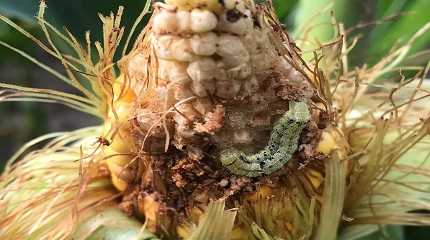
DENVER, the United States, July 29 (Xinhua) -- The harvest of Colorado's sweet corn this summer suffered a drastic drop due to an earworm infestation. Scientists warn the pest is spreading north due to climate change, endangering thousands more acres of crops.
The pest problem, linked with the severe drought plaguing the Midwest U.S., could lead to an increase in already high food prices, impacting American consumers' wallets.
DECIMATED HARVEST
Corn earworms (Helicoverpa zea) are drastically cutting production of Colorado's Olathe Sweet corn, which generates about 15 million U.S. dollars of agricultural revenue annually for some two dozen growers.
"We are scrambling. We are off balance. We are sad. We are embarrassed. We did not see this coming," David Harold, the son of John Harold who founded the Tuxedo Corn Company, the state's largest sweet corn producer, 41 years ago, told local media.
Now Tuxedo is only packing about 3,000 boxes per day for shipment to stores compared with three times that in a normal year.
Earworms come in the aftermath of last month's unprecedented infestation of millions of Mormon Locusts that covered roadways in Oregon and Idaho through northern Colorado, and parts of Wyoming and Nebraska. These events are proof that sudden insect proliferations are on the rise throughout the region, scientists warn.
Tuxedo workers discovered the worms in the corn in mid-July just as harvest was about to begin, leading Tuxedo to go into damage-control mode in the fields. The Harolds said they will have to abandon about 400 acres of fields entirely due to the pervasive infestation, according to local media.
Harold penned a plea for government aid to state Senator Michael Bennet. In his letter, Harold conveyed the urgency of the crisis local corn farmers are grappling with: "We have an EMERGENCY in sweet corn production in Western Colorado."
This story reflects American farmers' struggle amid the production situation having "deteriorated to the worst in decades" as major producing areas missed out on much-needed rains, observed Reuters on June 26 based on U.S. government data.
WARMING CLIMATE
There were warning signs way before the irregular infestation broke out this year.
Corn earworm is considered by some to be the most costly crop pest in North America. This pest feeds on a hundred plant species and is able to migrate up to 400 km in its lifetime, depositing eggs along the way.
In the past, earworms have been found in North America up to the latitude of around 40 degrees. However, their overwintering zones are creeping northward as the climate warms.
A 2022 study at North Carolina State University suggests that as warmer soil temperatures shift northward, the range of major insect pests, including earworms, may expand due to enhanced overwintering survival. The researchers advocated for predictive modeling of insect pest range shifts based on varying climate scenarios to help devise strategies that minimize crop losses in expansion areas.
Despite these clear signals, without sufficient assistance, Colorado farmers admitted this year they were late to apply pesticides to combat the expected problem.
EXTREME DROUGHT
Scientists attribute the sudden irregular surge in pests to "overwintering" during periods of extreme dryness.
Despite the 1,200-year historic drought, America's West experienced a deluge of mountain run-off water this late spring, due to record snowfalls over the 2022-23 winter that hit many mountainous regions across the West -- from California to Colorado -- a vast, high-elevation area in the throes of extreme drought conditions.
That extreme dryness, suddenly interrupted by the sudden snowpack and melt moisture, combined with insects dormant and ready to explode, created "a perfect storm" for the current deluge of insects in the west, scientists have said.




